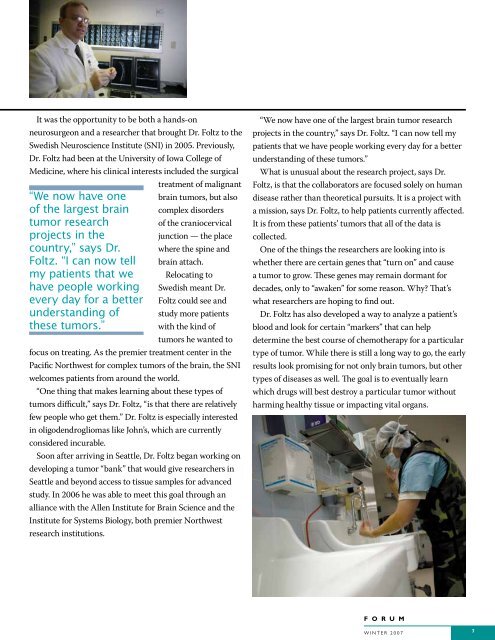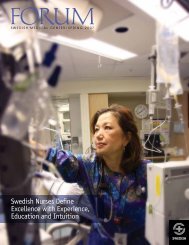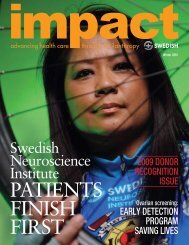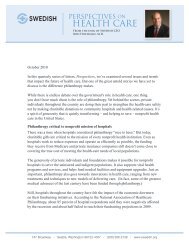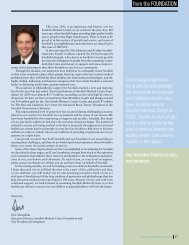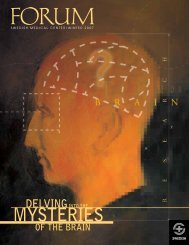Mysteries - Swedish Medical Center Foundation
Mysteries - Swedish Medical Center Foundation
Mysteries - Swedish Medical Center Foundation
- No tags were found...
Create successful ePaper yourself
Turn your PDF publications into a flip-book with our unique Google optimized e-Paper software.
It was the opportunity to be both a hands-onneurosurgeon and a researcher that brought Dr. Foltz to the<strong>Swedish</strong> Neuroscience Institute (SNI) in 2005. Previously,Dr. Foltz had been at the University of Iowa College ofMedicine, where his clinical interests included the surgicaltreatment of malignantbrain tumors, but alsocomplex disordersof the craniocervicaljunction — the placewhere the spine andbrain attach.Relocating to<strong>Swedish</strong> meant Dr.Foltz could see andstudy more patientswith the kind oftumors he wanted tofocus on treating. As the premier treatment center in thePacific Northwest for complex tumors of the brain, the SNIwelcomes patients from around the world.“One thing that makes learning about these types oftumors difficult,” says Dr. Foltz, “is that there are relativelyfew people who get them.” Dr. Foltz is especially interestedin oligodendrogliomas like John’s, which are currentlyconsidered incurable.Soon after arriving in Seattle, Dr. Foltz began working ondeveloping a tumor “bank” that would give researchers inSeattle and beyond access to tissue samples for advancedstudy. In 2006 he was able to meet this goal through analliance with the Allen Institute for Brain Science and theInstitute for Systems Biology, both premier Northwestresearch institutions.“We now have oneof the largest braintumor researchprojects in thecountry,” says Dr.Foltz. “I can now tellmy patients that wehave people workingevery day for a betterunderstanding ofthese tumors.”“We now have one of the largest brain tumor researchprojects in the country,” says Dr. Foltz. “I can now tell mypatients that we have people working every day for a betterunderstanding of these tumors.”What is unusual about the research project, says Dr.Foltz, is that the collaborators are focused solely on humandisease rather than theoretical pursuits. It is a project witha mission, says Dr. Foltz, to help patients currently affected.It is from these patients’ tumors that all of the data iscollected.One of the things the researchers are looking into iswhether there are certain genes that “turn on” and causea tumor to grow. These genes may remain dormant fordecades, only to “awaken” for some reason. Why? That’swhat researchers are hoping to find out.Dr. Foltz has also developed a way to analyze a patient’sblood and look for certain “markers” that can helpdetermine the best course of chemotherapy for a particulartype of tumor. While there is still a long way to go, the earlyresults look promising for not only brain tumors, but othertypes of diseases as well. The goal is to eventually learnwhich drugs will best destroy a particular tumor withoutharming healthy tissue or impacting vital organs.F O R U MW I N T E R 2 0 0 77


